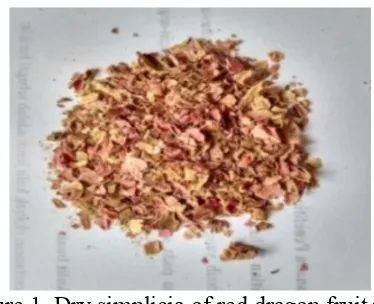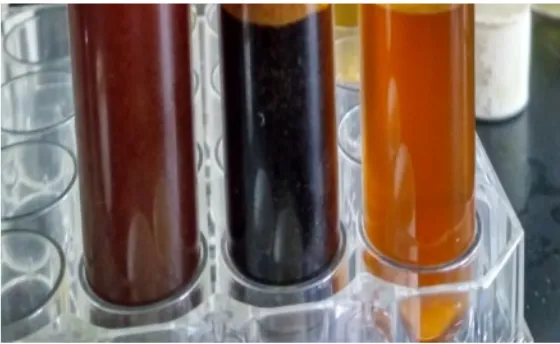THE PROFILE OF RED DRAGON FRUIT EXTRACT AS A NATURAL ANTIMICROBIALS IN REDUCING E. coli
Dewi Sartika1)a, Syarifah R.M2)b, danSutikno1)c
1) Student of Agricultural Product Technology Department, Faculty of Agriculture, University of Lampung
2) Lecturer of Agricultural Product Technology Department, Faculty of Agriculture, University of Lampung
3) Prof. Soemantri Brojonegoro Street, No. 1 Bandar Lampung, Lampung 35145
Email: adewikincai@yahoo.com, b syarifahrohana.048@gmail.com,
c sutiknolampung@yahoo.com
ABSTRACT
Red dragon fruit is a type of fruits that are widely consumed by the people of Indonesia because the content is very beneficial for health. Utilization of fruit is still the most part of the fruit, but red dragon fruit peel is still much discarded and untapped. The purpose of this research is to know the profile of red dragon fruit peel and its inhibitory activity in decreasing contamination of E. coli. This research is divided into two stages namely the phase of fruit peel extraction and the phase of inhibitory testing against contamination of E. coli bacteria. Red dragon fruit peel extract produced is a light brown, odorless, less viscous, and has a pH of 5.2. The test results produced inhibition against E. coli contamination at concentrations of red dragon fruit peel extract red 10%, 25%, 50%, 75%, 100%, respectively 3.58 mm, 3.97 mm, 4.95 Mm, 6.95 mm, and 9.30 mm. With these data, the inhibitory power of the red dragon fruit peel is still classified into the medium antimicrobial category.
KEYWORDS : Antimicrobial, Inhibitation, Echerichia coli, Red dragon fruit peel.
INTRODUCTION
Dragon fruit is a very potential commodity so that dragon fruit cultivation in Lampung Province increasingly in demand by farmers because of economic value, useful value and high market demand from dragon fruit. So the extent of the dragon fruit plant in Lampung Province is wider. South Lampung Regency is a center of dragon fruit cultivation in Lampung Province. South Lampung is the district with the largest amount of dragon fruit plantation area, recorded 52 hectares of the total area in Lampung Province (Nugraha, 2015).
The red dragon fruit has several ingredients that can be antimicrobial agent. The red dragon fruit has a phenolic-containing betalains and non-phenolic structure responsible for the ultimate purple Hylocereus antioxidant capacity, while non-betallic fenolics contribute only to a small extent of 7.21 ± 0.02 mg CE / 100 gram. Betalains are associated with anthocyanins (flavonoid derivatives), reddish pigments found in most plants. However, betalains are structurally and chemically like anthocyanins because they contain nitrogen while anthocyanins are not (Nurliyana et al., 2010). This is reinforced by Nurliyana et al. (2010) which states that red dragon fruit contains phenol and flavonoids. Flavonoids contained in red red dragon fruit include quercetin, kaempferol, and isorhamnetin (Panjuantiningrum, 2009). With some content in the red red dragon fruit, it is predicted that red dragon fruit peel also contains the active compounds betalains, phenols, and flavonoids although with a different percentage of the content. Utilization of this fruit skin content as antimicrobial subsequently expected to reduce contamination of E. coli up to a certain amount.
MATERIALS AND METHODS
Materials and tools
The materials used in this research are red dragon fruit skin obtained from Cendrawaih Metro Market, 96% ethanol, Mac Conkey Agar (MCA) media, Nutrient Agar, Nutrient Broth, Buffton Peptone Water, Aquades, Alcohol 70%, aluminum foil, Cotton and paper discs.
Research methods
The study was conducted in two stages separately. The first study aimed to obtain red dragon fruit peel extract. The second stage is testing the inhibitory power of red dragon peel in reducing contamination E.coli. Red dragon fruit peel extraction was done by using maceration method and 96% ethanol solvent. The red dragon fruit peel extract is then tested into Petri dish containing medium of Nutrient Agar and E. coli bacteria with paper disc method. Incubation is carried out for 24 hours at 37 ° C. The inhibitory zone diameter around the disc paper showing the antimicrobial activity of the extract is then measured using a sliding range.
RESULTS AND DISCUSSION
Red dragon peel extract is obtained from the process of extraction of simplicia that had previously experienced the drying process. According Tilaar (2009), the drying process aims to get the simplicia that is not easily damaged, so it can be stored in a longer time. In addition, drying also aims to stop the enzyme activity that can further describe the content of active substances in the sample and to facilitate the management in the next process (Nuria, 2010). Dry dried simplicia is made in powder form in order to increase the surface area of the raw material, this is because the more surface area the raw material will dry faster and can enlarge the contact with the solvent so that the desired active compound is more easily sintered (Gunawan et al. 2004). Dry simplicia of red dragon fruit peel as shown in Figure 1.
Figure 1. Dry simplicia of red dragon fruit peel. Source: Personal documentation
Nanas Jeruk Buah naga merah merah
color of brown is produced from the content of betalains, phenols, and phenolics contained in the skin of red dragon fruit. This brown color is not too brown when compared with some fruit peel extracts such as orange peel extract and pineapple peel extract are extracted with the same method and treatment. The faded brown color is predicted to be caused by damage to leather dragon fruit betalains content in the drying process. Betalains are natural pigments in dragon fruits that are affected by pH, light, air and water activity, with better pigment stability at low temperatures with a pH of 5.6 (Cai et al 1998). So if too long exposed to high temperatures will cause damage. Results of fruit peel extract can be seen in Figure 2.
Figure 2. Extract of citrus peel peel, pineapple peel, and red dragon fruit.peel. Source: Personal documentation
Figure 3. Inhibition zone of red dragon fruit peel extract. Source: Personal documentation
This zone is then measured in diameter by using a vertical or horizontal sliding threshold. Furthermore, each diameter is reduced by the diameter of the paper disc and calculated on the average of each diameter of the clear zone. The average value is then the data zone of each inhibition treatment. The test results of inhibition zone of red dragon fruit skin extract against E. coli bacteria can be seen in Table 1.
Table 1. The test results of dragon zone extract of red dragon fruit skin against E. coli bacteria.
Perlakuan Konsentrasi (%) Zona hambat (mm)
10 3,58
25 3,97
50 4,95
75 6,95
100 9,30
the higher concentration of the extract, the content of active substances that work as a natural antimicrobial is higher too.
The red dragon fruit has betalains containing phenolic and non-phenolic structures. Betalains associated with anthocyanins are flavonoid derivatives (Nurliyana et al., 2010). Flavonoids contained in red dragon fruit include quercetin, kaempferol, and isorhamnetin (Panjuantiningrum, 2009). The mechanism of action of phenol compounds in killing bacterial cells is 3 ways, namely denaturing the bacterial cell protein, inhibiting cell wall synthesis, and destroying bacterial cell membranes. The phenol compound denatures the bacterial cell protein by forming a hydrogen bond with a bacterial protein. This results in the structure of bacterial proteins becoming damaged and enzymes become inactive. Due to the denaturation of bacterial cell proteins, all of the bacterial cell metabolism activity stops, because all bacterial cell metabolism activities are catalyzed by enzymes that are proteins (Lawrence and Block, 1968). The mechanism of phenol in inhibiting bacterial cell wall synthesis by poisoning the protoplasm and breaking the peptidoglycan bond (Naidu, 2000).
According to Volk and Wheeler (1993) the mechanism of phenol in damaging bacterial cell membranes, by way of H + ions from phenol compounds will attack the polar group (phosphate group) bacteria so that the phospholipid molecules decompose into phosphoric acid, glycerol and carboxylic acids. This condition causes the bacterial cell membrane to leak. Similarly with flavonoid compounds, flavonoid compounds have 2 ways to kill bacteria that is by destroying the bacterial cell membrane and denaturing the bacterial cell protein. The mechanism of action of flavonoid compounds in destroying bacterial cell membranes is to form complex compounds with extracellular proteins so that the bacterial cell membranes are damaged and followed by the entry of uncontrolled water into the bacterial cells, causing swelling and eventually the bacterial cell membranes rupture (Black and Jacobs, 1993 ). This is reinforced by Harborne (1987) which states that flavonoid compounds have the ability to mendenaturasi protein cell bacteria by forming a complex hydrogen bond with bacterial cell protein. Thus, cell wall structures and bacterial cytoplasmic membranes that contain proteins, become unstable and lose their biological activity, consequently the function of bacterial cell permeability is disrupted and bacterial cells undergo lysis resulting in bacterial cell death.
the structural components of bacterial cell membranes. Cell membranes composed of proteins and lipids are particularly susceptible to chemicals that can reduce surface tension. Cell membrane damage causes a disruption of nutrient transport (compounds and ions) so that bacterial cells experience nutritional deficiencies necessary for their growth.
According to Davis and Stout (1971) in Saraswati (2015) which states that if the inhibit zone formed on the diffusion test is less than 5 mm in size, the inhibitory activity is categorized as weak. When the 5-10 mm inhibit zone is categorized as being, 10-19 mm is categorized strong and 20 mm or more is categorized as very strong. Based on the observation and measurement of the diameter of the dragon green peel estrak drainage area at concentrations of 10%, 25%, and 50%, the inhibitory power of the extract is still categorized into a weak inhibitory power. Meanwhile, at concentrations of 75% and 100%, the inhibitory power of red dragon fruit skin can be categorized into moderate inhibitory power.
CONCLUSIONS
Based on the results of research that has been done then obtained the following conclusions:
1. Extract of red dragon fruit skin that is produced that has a light brown color, odorless, less viscous, and has a pH of 5.2.
2. The test results of inhibitory power of red red dragon fruit extract produced on contamination of E. coli at 100% concentration that is equal to 9,30 mm. Thus, the inhibitory power of red dragon fruit skin is still classified in the medium antimicrobial category.
Black, J. M. and E. M. Jacobs. 1993.Medical Surgical Nursing. 4th edition. Philadelphia: W. B. Saunders Company.
Cai, Y., M. Sun., H. Wu, R. Huang and H. Corke. 1998. Characterization and quantification of betacyanin pigments from diverse Amaranthus species. J. Agric. Food Chem. 46(6):2063-2069.
Gunawan., Didik dan Sri, M. (2010). Ilmu Obat Alam (Farmakognosi) jilid 1, Jakarta: Penebar Swadaya. Halaman 106, 107, 120.
Harbone, J. B. 1987. Metode Fitokimian Penuntun Cara Modern Menganalisis Tumbuhan. ITB. Bandung.
Lawrence, C. A. and S. S. Block. 1968.Disinfection, Sterilization and Preservation. Philadelphia: Lea and Febiger.
Naidu, A. S. dan R. A. Clemens. 2000. Natural Food Antimicrobial Systems. LCC: CRC Press.
Nuria, M.C., A. Faizatun., dan Sumantri.2009. Uji Antibakteri Ekstrak Etanol Daun Jarak Pagar (Jatropha cuircas L) terhadap Bakteri Staphylococcus aureus ATCC 25923, Escherichia coli ATCC 25922, dan Salmonella typhi ATCC 1408. Jurnal Ilmu –ilmu Pertanian. 5: 26 –37.
Nurliyana, R., dkk. 2010. Antioxidant Study of Pulps and Peels of Dragon Fruits: A Comparative Study. International Food Research Journal. 17: 367-375.
Panjuantiningrum, Feranose. 2009. Pengaruh Pemberian Buah Naga Merah (Hylocereus Polyrhizuz) Terhadap Kadar Glukosa Darah Tikus Putih Yang Diinduksi Aloksan. Skripsi. Universitas Sebelas Maret. Solo.
Reveny, Julia. 2011. Daya Antimikroba Ekstrak dan Fraksi Daun Sirih Merah (Piper betle Linn.). Skripsi. Fakultas Farmasi Universitas Sumatra Utara. Medan.
Saraswati, F.N., 2015. Uji AKtivitas Antibakteri Ekstrak Etanol 96% Limbah Kulit Pisang Kepok (Musa Balbisiana) terhadap Bakteri Penyebab Jerawat (Staphylococcus epidermidis, Staphylococcus aureus,dan Propionibacterium acne). (Skripsi). UIN Syarif Hidayatullah. Jakarta. 67 hlm.
Tilaar, M., 2009, Healthy Lifestyle with Jamu¸ Dian Rakyat, Jakarta, p. 67.


